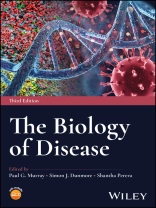All-new edition of a classic textbook bridging the gap between human biology and clinical practice
The Biology of Disease provides a comprehensive overview of the principles of the disease process. Building on the success of previous editions, this all-new Third Edition reflects the unprecedented challenges that the global community now faces in the field, as well as advances in the basic sciences of cell biology, immunology, and the molecular mechanisms of disease, with all chapters extensively modified to ensure that they remain at the cutting edge of current knowledge.
Each section is followed by case studies which bridge the gap between theory and clinical practice. This Third Edition includes 72 case studies in total, of which 34 are new. All diagrams and figures have been updated to present the most relevant information at a glance, and a new companion website with more than 500 multiple choice questions in two difficulty levels has been made available.
Written by three highly qualified academics with significant experience in the field, The Biology of Disease includes information on:
- Emergence of new and drug resistant pathogens and an increasing recognition of the environmental factors, including climate change, that influence health
- The growing impact of diet and physical inactivity on the development of obesity and related disorders including cancer and type 2 diabetes
- Principles of epidemiology, cell reproduction, injury and death, inflammation and disorders of immunity
- Disorders of blood and blood vessels including anaemia, vascular disorders, and disorders of haemostasis
The Biology of Disease is an essential textbook resource for medical students with a focus in physiology, pathophysiology, or pharmacology, along with undergraduate students in biomedical science, biomedicine, medical biochemistry, and human biology.
विषयसूची
PART 1: BASIC PRINCIPLES OF DISEASE
1. The Nature of Disease
2. Principles of Epidemiology
PART 2: CELL REPRODUCTION, INJURY AND DEATH
3. Cell Reproduction, Injury and Death
PART 3: INFECTIOUS DISEASES
4. Infectious Diseases
Case Studies 1 to 13
PART 4: INFLAMMATION AND DISORDERS OF IMMUNITY
5. Inflammation and Repair
6. Disorders of the Immune System
Case Studies 14 to 33
PART 5: DISORDERS OF BLOOD AND BLOOD VESSELS
7. Anaemia
8. Disorders of Haemostasis
9. Vascular Disorders
Case Studies 34 to 40
PART 6: GENETIC DISORDERS
10. Genetic Disorders
Case Studies 41 to 50
PART 7: NEOPLASIA
11. Neoplasia
Case Studies 51 to 68
PART 8: OBESITY, DIABETES AND ENVIRONMENTAL DISEASES
12. Nutritional Disorders and Obesity
13. Diabetes
14. Toxicology and Environmental Diseases
Case Studies 69 to 72
APPENDIX
Reference ranges in haematology
Reference ranges in clinical biochemistry
लेखक के बारे में
Prof. Paul G. Murray, Department of Pathology, Royal College of Surgeons in Ireland-Medical, University of Bahrain. Professor of Molecular Pathology at University of Limerick, Ireland, and Honorary Professor, University of Birmingham, United Kingdom.
Dr. Simon J. Dunmore, Honorary Clinical Senior Lecturer, School of Medicine, Medical Sciences and Nutrition, University of Aberdeen; Honorary Lecturer, Cardiovascular Sciences, School of Medicine, University of Edinburgh; NHS Scotland (Grampian).
Dr. Shantha Perera, Visiting Senior Lecturer, School of Life Sciences, University of Wolverhampton, United Kingdom.












